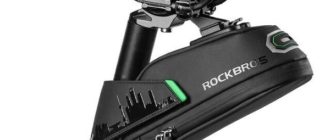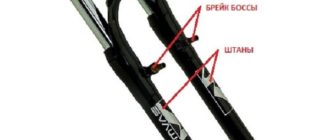Riding a bicycle brings a lot of pleasure, improves health and expands horizons, but this mode of transport carries with it a danger, especially at dusk and at night, if the cyclist has not tried to make himself more visible to the rushing cars, fixing reflectors on the bike. Let’s talk today about light reflectors, what they are, where and what kind of reflectors are mounted on a bicycle, as well as on how they can make their own hands.
What are bicycle reflectors
Not all riders know what bicycle reflectors are, because they are more commonly known as reflectors. They look like small plates of different colors and are needed to reflect incoming light with minimal scattering.
The design of the reflectors are several mirrors placed at right angles. When a ray of light enters between these mirrors, it is reflected by 180. The length of such a reflected beam is quite significant – 150 meters, so the bike is visible to car drivers at a decent distance, which helps have time to orientate in case of emergency and prevent an accident.
Elements are made of glass or cheaper plastic, framed in chrome-plated metal or polystyrene. There are models that are made of acrylic. Manufacturers of more modern cataphotos offer models with LEDs already built in, which themselves are already a light source. The body has a metal mount. Install reflectors on certain parts of bicycles.
Traffic rules about reflectors
In the traffic rules clearly indicate where you need to attach reflectors on a bicycle. The whole point is that reflectors of light have three varieties: white, red and orange colors, each of which is installed in a strictly defined place, so as not to mislead other road users:
- the front cataphot on the bike must be white, it is installed above the handlebar tube or attached to the trunk (or basket), if it is in the front. You can also attach it between the legs of the handlebar fork on the jumper;
- the rear reflector is red and can be mounted directly under the seat on the seatpost or on the rear fender. If you have a trunk at the rear, you can mount the cataphractor directly on it;
- orange reflectors must be attached to the spokes on the sides – one for each wheel in the case of two-sided models and two for each wheel in the case of one-sided models. In principle, it is permitted to install one reflector on single-sided models, just be sure that they point to the left and to the right.
Different kinds of reflectors
There are four varieties of reflectors that have their own functional features. Consider each of them in detail.
Dimensional reflectors
Cataphotas can only reflect light rays falling on them in the dark, so they are called passive light sources. If you will be riding your bike only in daylight, put a white reflector on the front and a red one on the back of the bike.
LED reflectors
Reflectors that have built-in LEDs are a new generation of devices – active light sources. Their task is not only to reflect the rays of light, but also to emit. This is especially important in bad weather, during heavy rain or when the fog thickens. Cataphotas with LEDs on a bicycle will make you more visible in bad weather. In these reflectors have a few diodes, operating on an electric current. However, for them to create a power source. In this case, they can act as an ordinary flashlight – the power of its batteries will be quite enough to recharge the lights.
Also to generate direct current in the process of riding you can dynamo machine, which is attached to the front wheel of the bike.
Reflectors on spokes
Unfortunately, not all cyclists perceive the side reflectors as necessary parts of the bike. Often this is due to the stereotypical unfavorable attitude toward them by professional riders. Previously, reflectors were heavy and, given the fact that they had to be installed on the spokes, they often caused a figure eight on the wheel and clung to the neighboring spokes. Nowadays, the side cataphotos are light in weight and, considering that the design can be mounted on a spoke, they will not affect the wheel alignment.
Important: Luminous yellow and orange cataphotas on spokes many times increase the safety of the rider on the track in the dark.
Plus, these original elements adorn the bike itself and improve the mood of its owner while riding. Modern light reflectors for spokes have a few dozen different shapes, a whole rainbow of colors and shades, some even have sound effects.
Light reflectors are powered by small batteries, they are not afraid of heavy rain or muddy puddles, as they are made waterproof.
Rotating Reflectors
Riders, for whom cycling has become a way of life, are happy to install stylish rotating reflectors on their units. It has already been proven that the flashing light is most noticeable in the dark and draws more attention than a steady stream of light without pulsation.
Movable elements are inside a transparent body, which protects the rider’s clothes from the rotating parts. With the triggering of a special wheel, the cataphore begins to work. Manufacturers also offer such sensitive models, in which the flashing light can appear even from a slight breeze.
About 70 years ago in America the idea to develop rotating models of light reflectors for vehicles first appeared. John Parker invented and then obtained a patent for a device that clung “petals” to the spokes of the wheels and swung a mirrored surface by means of a soft spring. This allowed the reflected light to start flashing. But the invention had its shortcomings, which did not give wide distribution of these cataphotos on the wheels of bicycles:
- it had to be mounted too close to the ground, and in this position, the device is almost invisible from a person’s height;
- the device protrudes significantly away from the wheel, making it easily damaged in collisions with curbs, bike parking poles and other objects.
Another inventor, LaLonde created his rotating cataphot. It has two rotating reflectors mounted on the axle of a wheel hooked at the highest point with the front or rear wheel. Due to the high position of the cataphot flashing light is visible to others, but this cataphot turned out to be too weighty and cumbersome for bikes. In addition, it has an open movable parts that quickly get clogged with grass and road debris, and they constantly get clothes rider. Because of these shortcomings, the invention was also left out.
Mike Curran considered the shortcomings of the models of previous inventors, and introduced his device with a transparent cap, which protects the moving elements from the effects of moisture and dirt, as well as from getting clothes. Curran’s cataphracts are small, fairly easy to attach to the bike. This device and became the most suitable for cycling enthusiasts.
Today it is possible to assemble their own hands rotating bicycle reflectors, using the drive from a small electric motor.
How to make your own hands cataphotts
- It will not be very difficult to make a reflector on a bicycle on your own. The simplest thing: you can take special stickers for bicycles, which are easily removed in case of need. Take stickers of colors that will comply with the rules of installation of light reflectors (front, sides and back). It’s best if you combine the stickers with standard cataphotas as extras to increase your visibility to others.
- Another option would be to have the lights in the form of tape with LEDs, which should be placed on the frame or in different places on the bike. It is recommended to treat the silicone sealant on the attachment points of this tape. You will also need a power source which will provide the tape power.
Selection Guidelines
Before you buy the reflectors on your bike, look at what material they are made of. It is best if they will be plastic – this material is more durable, as opposed to glass models that can break or deform on the road.
Pay attention to the size of the reflectors – the bigger they are the better.
For the sides of the bike choose lightweight models of cataphotos, so as not to weigh the wheels and not to impair the control of the unit.
Conclusion
Cataphotas on the bike are installed in order to protect the owner of the bike from accidents and for the safe movement of other participants on the track. Do not neglect such important elements on your bike – it is the key to a comfortable ride in the dark. Try to choose roads with the least heavy traffic while riding, but if there is no such a possibility, protect yourself from trouble as much as possible by properly installing reliable reflectors for your bike.









